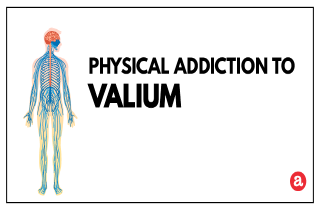Q: If you are physically dependent on Valium, does this mean that you are addicted to it?
A; No, not necessarily.
However, Valium is an addictive drug and long term use can manifest symptoms similar to addiction. More on becoming physically dependent on Valium and options for treatment in the text that follows. After you finish reading, feel free to ask your questions or post your comments about physical Valium addiction at the end. We try to respond to all legitimate questions with a personal and prompt reply.
Physical dependence on Valium
Anyone who takes Valium regularly can develop physical dependence to diazepam, the main psychoactive ingredient found in the drug. In fact, diazepam is capable of causing mild physical and psychological dependence and is regarded as having a significant abuse potential. But how does physical dependence differ from addiction? And can you get addicted to Valium in the first place?
Basically, addiction is a psychological condition while dependence is a physical one. Physical dependence is an anticipated outcome of regular dosing. Physical dependence occurs because of normal adaptations to chronic exposure to a drug and is not the same as addiction. So while you can be physically dependent on Valium, you MAY NOT BE NECESSARILY ADDICTED TO IT.
Once physical dependence to benzodiazepines like Valium have developed, termination of treatment will be accompanied by withdrawal symptoms. The risk is more pronounced in patients on long-term therapy. Chronic use (even at therapeutic doses) may lead to the development of physical dependence: discontinuation of the therapy may result in withdrawal or rebound phenomena. So, what are these signs of physical dependence?
Physical signs of addiction to Valium (dependence)
Signs most commonly reported on people find to by physically dependent on Valium include drowsiness, fatigue, muscle weakness, and ataxia. The following have also been reported:
- Cardiovascular System: hypotension
- Central Nervous System: confusion, depression, dysarthria, headache, slurred speech, tremor, vertigo
- Gastrointestinal System: constipation, nausea, gastrointestinal disturbances
- Urogenital System: incontinence, changes in libido, urinary retention
- Senses: blurred vision, diplopia, dizziness
- Skin and Appendages: skin reactions
- Other: changes in salivation, including dry mouth, hypersalivation
Addiction-prone individuals (such as drug addicts or alcoholics) should be under careful surveillance when receiving diazepam or other psychotropic agents because of the predisposition of such patients to habituation or Valium abuse. Unlike physical signs, the symptoms of Valium addiction are mainly psychological in nature: craving, loss of control, and continued use despite negative consequences.
Treating physical symptoms of addiction to Valium (dependence)
If you are ready to stop using Valium and have developed a dependence to the drug, ALWAYS SEEK MEDICAL SUPERVISION. Central nervous system depressants like Valium work by slowing the brain’s activity, so when you stop taking them, there can be a rebound effect, resulting in seizures or other harmful consequences.
For patients who have used high doses of benzodiazepines for an extended period of time, hospitalization is always prudent when you stop using Valium. Outpatient detoxification should be reserved for patients whose doses of benzodiazepines were mainly in therapeutic ranges, who do not have polysubstance dependence, and who are reliable and have reliable significant others to aid in monitoring and supervising their progress. In the outpatient setting, patients and families need to be informed that even with sound withdrawal treatment, seizures and delirium are possible.
The best way to avoid serious withdrawal symptoms is to reduce the amount of medication you are taking or how often you are taking them before you run out. Cutting the amount by 25% per day or an additional 25% every other day is fairly rapid and may result in some withdrawal symptoms but it is better than suddenly stopping them when you run out.
Physically addicted to (dependent on) Valium questions
Do you still have any questions about physical dependence on Valium? Please feel free to contact us by asking them in the section below. We are eager to hear more about your experience with Valium and we’ll try to provide prompt and personal responses to all legitimate queries.









Related Posts